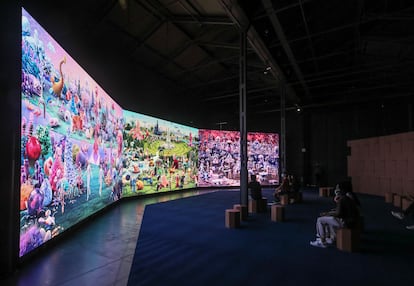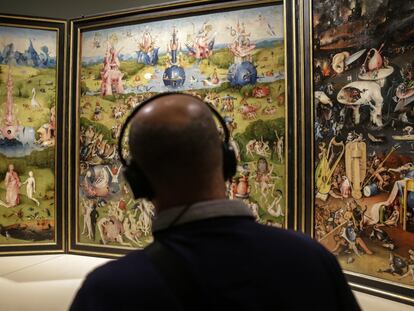Renaissance meets AI art: Madrid exhibition reimagines Bosch’s ‘Garden of Earthly Delights’
Contemporary artists have revisited one of the most famous paintings at the Prado Museum and come up with tech-based versions now on display at the Matadero center


Be good, do not cave in to lust and you will be spared the horrors of hell. This highly familiar moralizing message is clearly conveyed by The Garden of Earthly Delights, painted by Hieronymus Bosch five centuries ago. Although, Bosch’s depiction of hell looks not so much like a fiery place where the souls of sinners burn for eternity as a rave party that’s spun out of control. The place is filled with deviant humans and odd-looking animals performing strange acts.
The complexity of this artwork, with its wealth of small stories and details, means that any art lover – in fact, any alert citizen – can easily spend hours gazing at it. “At other periods of time it was used as something like going to the movies before movies even existed: the owner could invite the VIPs of the day to his house, open up the triptych – which has a much more sober view of the world on its outer panels – and amaze his guests with the exuberant fantasy world concealed within,” explains Rebekah Rhodes, director of Documentation and Publications at Colección SOLO, a Madrid-based international arts project.
Painted between 1490 and 1510, The Garden of Earthly Delights continues to pack the same punch as it did centuries ago: it remains one of the most viewed works at the Prado Museum in Madrid, where it has been housed since 1939. The strong inspiration produced by these painted panels recently led a group of 15 contemporary artists to create new art based on the original painting, but using modern techniques such as sound art, video games and even artificial intelligence. The result of their reinterpretation is an exhibition curated by Colección SOLO and co-produced by the cultural center Matadero Madrid that will be open to the public at the latter space until February 2022. Most of the 18 works on display were made specifically for this exhibition where the Renaissance meets 21st-century interactive art.

Three giant LED screens measuring 4 x 7 meters each make up Speculum, an artwork by the Dutch collective SMACK whose members have come up with a digital, post-modern view of the original painting. Speculum creates a sensory overload with an updated version of the garden in pastel shades where some characters are being tormented with needles and psychoactive drugs while drones fly overhead and refugees on boats attempt to enter hell (only to find a wall barring the way there too). There are pets from TV shows, trees that produce wasteful plastic containers instead of fruit, and instead of God we see an effigy of physicist Isaac Newton.
The layout of the exhibition mimics a cardboard labyrinth, deepening the sense of mystery for visitors about to be treated to Dave Cooper’s orgy of penis-plants and nipple-flowers, Enrique Del Castillo’s Umbráfono, an optical reader that transforms patterns on 35mm film into sound, and to a Book of Genesis featuring mice, by Lusesita.
“We realized there was a gap for artists who use technology to express themselves,” says Óscar Hormigos, director of Development for SOLO. “If it’s hard for any beginning artist to break through, it’s even more so for these kinds of artists.”
The Spanish-Croatian artist Filip Custic, best known for having designed the visual identity for El malquerer, a 2018 album by the Spanish singer Rosalía, has created a sequence of panels where he imagines human evolution as it reaches the gender-fluid stage. But perhaps the most advanced demonstration of tech applied to art is the work by Mario Klingemann, who used AI techniques to turn The Garden of Earthly Delights into a work in constant flux: his algorithms change or repair various parts of the painting, changing its textures and making it more liquid or abstract. “Although it’s the artist who created the piece, it is the machine that’s doing art autonomously,” notes Hormigos.
When: Until February 27, 2022. Where: Matadero cultural center (Plaza de Legazpi, 8). Price: Free admission
Tu suscripción se está usando en otro dispositivo
¿Quieres añadir otro usuario a tu suscripción?
Si continúas leyendo en este dispositivo, no se podrá leer en el otro.
FlechaTu suscripción se está usando en otro dispositivo y solo puedes acceder a EL PAÍS desde un dispositivo a la vez.
Si quieres compartir tu cuenta, cambia tu suscripción a la modalidad Premium, así podrás añadir otro usuario. Cada uno accederá con su propia cuenta de email, lo que os permitirá personalizar vuestra experiencia en EL PAÍS.
¿Tienes una suscripción de empresa? Accede aquí para contratar más cuentas.
En el caso de no saber quién está usando tu cuenta, te recomendamos cambiar tu contraseña aquí.
Si decides continuar compartiendo tu cuenta, este mensaje se mostrará en tu dispositivo y en el de la otra persona que está usando tu cuenta de forma indefinida, afectando a tu experiencia de lectura. Puedes consultar aquí los términos y condiciones de la suscripción digital.
More information
Últimas noticias
Most viewed
- Alain Aspect, Nobel laureate in physics: ‘Einstein was so smart that he would have had to recognize quantum entanglement’
- Maps of the US attack on Venezuela: Targets, airspace and deployed fleet
- Oil, gold and rare earth elements: the backdrop to US political tension with Venezuela
- Key points of the military attack on Venezuela: Early morning bombings and a ‘captured’ president
- The US bombing of Venezuela, in pictures










































